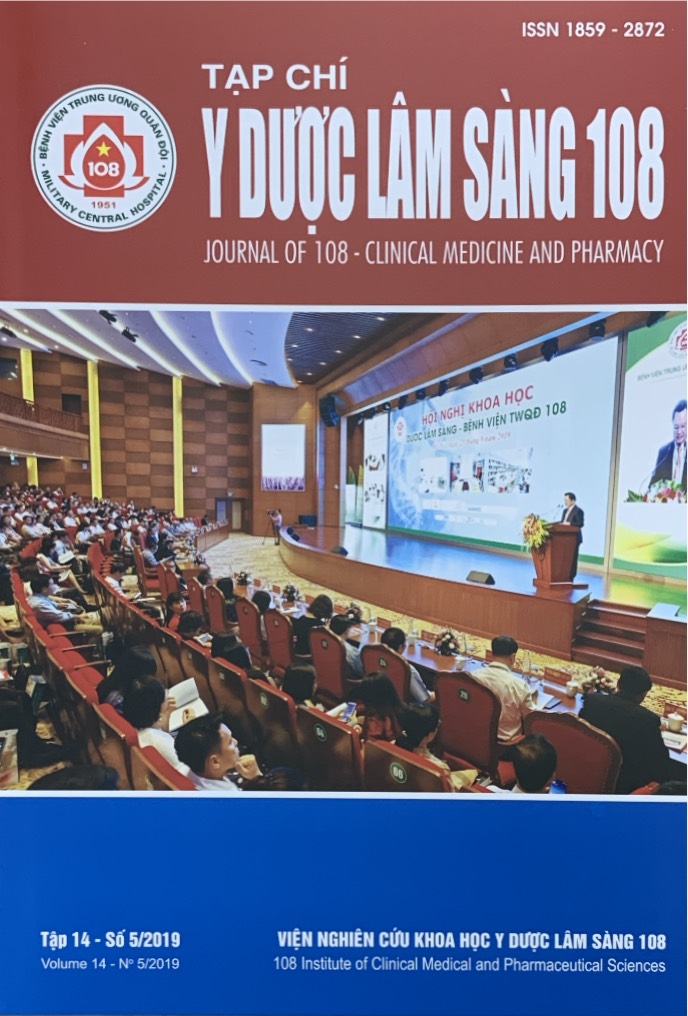BRAF V600E mutation and relationship with histophathologic characteristics of metastatic, recurrent differentiated thyroid carcinoma
Main Article Content
Keywords
Abstract
Objective: To investigate the prevalence of BRAF V600E mutation and relationship between BRAF V600E and histophathological characteristics of metastatic, recurrent differentiated thyroid carcinoma. Subject and method: Histological samples were collected from 104 patients who underwent surgical operation for lesions of recurrent, metastatic differentiated thyroid carcinoma at 108 Military Central Hospital from March 2012 to July 2018. Histophathological assessment was undertaken for all collected samples. BRAF V600E mutation was determined by realtime PCR using the CE-IVD, thyroid cancer mutation analysis kit. Result: Of the 104 patients, 14 (13.5%) had recurrence at thyroid bed, 94 had (90.4%) lymph node metastasis, and 7 (6.7%) had other metastasis. BRAF V600E mutation was found in 70.2% examined samples. Papillary thyroid carcinoma was the most common (96.1%), follicular thyroid carcinoma takes into account 3.9%. The prevalence of BRAF V600E mutation among extra-lymph node invasion samples was 2.5 times higher than that among non-invasion ones (95% CI: 1.02 - 6.55), there was no significant relationship between BRAF V600E mutation and vascular invasion, necrosis and calcification lesions. Conclusion: The prevalence of BRAF V600E mutation in recurrent, metastatic differentiated thyroid carcinoma was high (70.2%), and was associated with extra-lymph node invasion.
Article Details
References
2. Nakayama H, Nakamura Y, Hayashi H et al (2007) Clinical significance of BRAF (V600E) mutation and Ki-67 labeling index in papillary thyroid carcinomas. Anticancer Res 27(25B): 3645-3649.
3. Xu X QR, Gattuso P et al (2003) High prevalence of BRAF gene mutation in papillary thyroid carcinomas and thyroid tumor cell ines. Cancer 63(15): 4561-4567.
4. Xing M (2010) Prognostic utility of BRAF mutation in papillary thyroid cancer. Mol Cell Endocrinol 321(1): 86-93.
5. Xing M, Alzahrani AS, Carson KA, Shong YK, Kim TY, Viola D et al (2015) Association between BRAF V600E mutation and recurrence of papillary thyroid cancer. J Clin Oncol 33(1): 42-50.
6. Barollo S, Pennelli G, Vianello F, Watutantrige Fernando S, Negro I, Merante Boschin I et al (2010) BRAF in primary and recurrent papillary thyroid cancers: The relationship with (131)I and 2-[(18)F]fluoro-2-deoxy-D-glucose uptake ability. Eur J Endocrinol 163(4): 659-663.
7. Al SBe (2010) AJCC cancer staging manual 7th edition. Springer: 87-96.
8. Haugen BR, Alexander EK, Bible KC, Doherty GM, Mandel SJ, Nikiforov YE et al (2016) 2015 American thyroid association management guidelines for adult patients with thyroid nodules and differentiated thyroid cancer: The american thyroid association guidelines task force on thyroid nodules and differentiated thyroid cancer. Thyroid 26(1): 1-133.
9. Ricarte-Filho J, Ganly I, Rivera M, Katabi N, Fu W, Shaha A et al (2012) Papillary thyroid carcinomas with cervical lymph node metastases can be stratified into clinically relevant prognostic categories using oncogenic BRAF, the number of nodal metastases, and extra-nodal extension. Thyroid 22(6): 575-584.
10. Knauf JA, Sartor MA, Medvedovic M, Lundsmith E, Ryder M, Salzano M et al (2011) Progression of BRAF-induced thyroid cancer is associated with epithelial-mesenchymal transition requiring concomitant MAP kinase and TGFbeta signaling. Oncogene 30(28): 3153-3162.
 ISSN: 1859 - 2872
ISSN: 1859 - 2872
